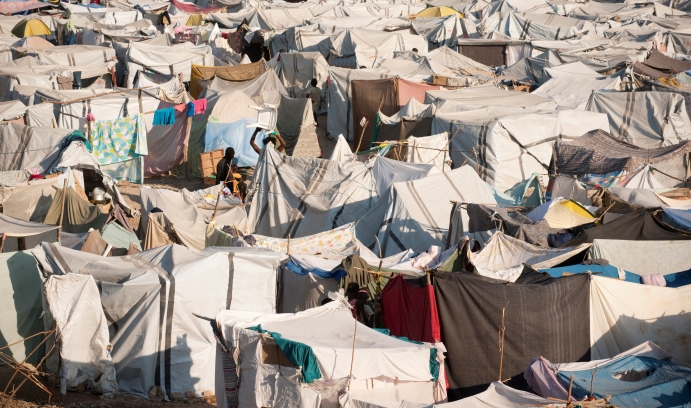More empowered women = fewer disaster victims

A camp in Haiti temporarily housed people displaced by a major earthquake in 2010. According to Amnesty International, 123 camps were housing 85,432 displaced people in Haiti in September 2014. (Photo by iStock/Claudia Dewald)
Among the bad news related to the ill effects of climate change is that women are impacted disproportionately by the resulting disasters. Women are more likely to experience poverty, poorer health outcomes and increased vulnerability to sexual violence due to climate-related disaster events, such as floods, storms and drought.
These facts are confirmed by new research that aims to quantitatively assess the causes of suffering from disasters in less-developed nations with a specific emphasis on gender relations. The research also reveals some good news: women who are economically empowered have a disproportionately positive impact on disaster outcomes—reducing the overall number of people affected.
Kelly F. Austin, assistant professor of sociology at Lehigh, and Laura A. McKinney of Tulane University looked at data from 85 less developed nations for their study, the results of which have been published in an article in Social Forces titled “Disaster Devastation in Poor Nations: The Direct and Indirect Effects of Gender Equality, Ecological Losses, and Development.”
Austin and McKinney found that advancing the economic status of women reduces the number of people directly affected by disasters, as economically empowered women can better prepare for and respond to disasters. This improved status also has the indirect benefit of enhancing health resources in the community, thus helping to reduce harm and prevent deaths.
“Our analysis illustrates a clear connection between female economic empowerment and a reduction in the total number of disaster victims,” said Austin, who directs Lehigh’s Health, Medicine and Society Program.
“The key drivers are a tendency for women to use their earnings to meet basic needs that improve public health conditions, such as education fees, healthcare costs, clean water and sanitation services, as well as the fact that women routinely provide relief efforts to the household and broader community in the aftermath of disasters.”
Austin and McKinney urge that women be recognized as agents of harm reduction and advocates of community development. They also recommend that improving the economic empowerment of women be included as a part of any comprehensive plan to combat climate change and to mitigate damage from disasters.
Gender, the environment and disaster vulnerability
The 85 countries sampled by the two researchers report data for the key variables in their analysis, including the percentage of people affected by disasters and women’s economic status. The sample included only less-developed nations that have experienced a flood, storm or drought in which people have been affected for any year from 2001-2010.
Austin and McKinney measured the harm caused by disasters by examining the number of people affected, injured, left homeless, or killed due to floods, storms or droughts—which are some of the most common and severe disasters associated with climate change dynamics. They measured women’s economic status with three key variables: women’s access to ownership of land, legal access to ownership of property other than land, and legal access to credit or loans.
Of particular note in their findings is the high correlation among indicators for women’s economic status (access to land, loans, property) and public health resources (healthcare works, clean water, secondary schooling).
“The results…demonstrate that…women’s economic status and environmental losses represent important influences that contribute both directly and indirectly to the proportion of people affected by disasters in less developed nations,” Austin and McKinney wrote in Social Forces.
“The results also establish that public health resources are directly significant in explaining cross-national variability in injury, illness, homelessness, and death due to climate-related disasters. Specifically, we find that public health resources measured with the number of health workers, access to clean water, and participation in secondary schooling are associated with decreased suffering and death from storms, floods, and drought…
“Women’s economic status also has a notable direct influence on the proportion of people affected by disasters, where nations’ increased access to ownership of land, loans, and property by women reduces injury, illness, homelessness and death from disasters…”
Include women and focus on preparedness
The results of the study by Austin and McKinney suggest that that when looking at disaster vulnerabilities and the unequal impact of environmental degradation, there should be an explicit emphasis on the role of women in mitigating harm.
“Public policies and initiatives to address climate change effects,” the researchers wrote, “would similarly benefit by recognizing women as agents of harm reduction and advocates of community development.”
The paper refers to a 2014 United Nations Framework on Climate Change report that said: “It is increasingly evident that involving women and men in all decision-making processes on climate action is a significant factor in meeting the climate challenge.”
The authors point out that the same report also acknowledges that women are underrepresented in all levels of the decision-making process on efforts to combat climate change and that this is limiting.
The results of their research suggest a need to shift from post-disaster response to preparedness before a disaster strikes, they say.
“…Rather than focusing on disaster response, the conversation needs to more fully emphasize disaster preparedness,” the researchers wrote in Social Forces. “Current global governance strategies outlined in the UN’s Sustainable Development Goals that call for governments to strengthen resilience, adaptive capacity, and impact reduction are steps in the right direction, but in practice global institutions have focused more on post-disaster response (e.g., coordinating NGOs that respond to disasters) rather than pre-disaster preparedness.”
Preparedness makes good economic sense, the authors say. Reports indicate that for every dollar spent on basic preparation, including provisions for health infrastructure like hospitals and clean water facilities, $7 in disaster aid and recovery is prevented.
Story by Lori Friedman
Posted on:




